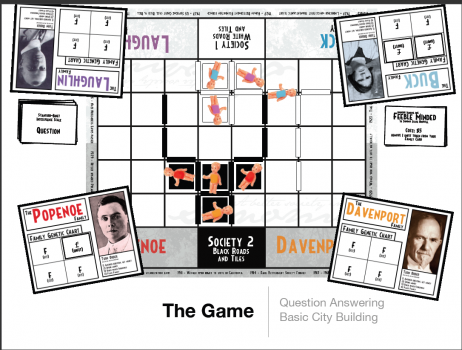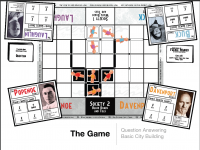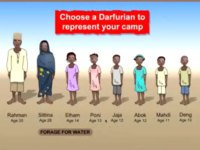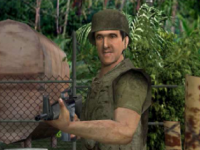Three Generations Newsgame
Three Generations, which I (Nonny de la Peña) designed alongside Simon Wiscombe was selected as a demo at Games For Change. Here’s some details

Three Generations
Developers / Designers Nonny de la Peña and Simon Wiscombe
Synopis Three Generations is a board game designed to introduce and ignite both an emotional reaction and an intellectual discourse about the Californian Eugenics movement that transpired in the early 1900s. The core design focuses on embracing its interactive nature in order to convey a primarily emotional experience as well as an informative one. Four players (known as Families within the game) are separated so that two Families become a team and play against the other two Families with the objective of “expanding the city of Sonoma.” Using resource-management, teams build up roads and buildings from either side of the board to gain the most ground and property. Each round of play is a “generation”, and players must place one more family member (Child) on the board (each building and road can house one child each). The money to buy these buildings and roads is gained by answering questions from the Stanford-Binet IQ test designed by Lewis Terman in the 1920’s. Answer correctly, and players are awarded with money to spend (the amount is modified positively by children in buildings and negatively by children on roads), otherwise the player receives one “unfit” token. Enough unfit tokens, and the player is declared feeble-minded, whereby they produce two children per turn and receive no monetary bonus when they answer questions. The other player on the team may make the decision to send their unfit teammate to be sterilized. Once sterilized, the player’s presence on the board slowly vanishes until they are out of the game completely. Play-testing has shown that the players, regardless of previous knowledge about the subject matter, come to a realization about the implications of their play and how it extends beyond the confines of the game’s boundaries. This elicits the desired goal: a discussion about not only the historical pretext, but their own emotional reactions to their personal involvement in a system that supports eugenics.
Intended Audience, Context, and Objectives Three Generations is a board game dealing with the inherent social biases of the Californian Eugenics movement. While the term “eugenics” originated with Francis Galton (cousin of Charles Darwin) in the late 1800s, it gained a very large following in the United States in the early 1900s. Although the eugenics philosophy employed later by National Socialists in Germany was based largely on the idea of superior genetics among races, the mindset that caught ground in California was largely due to money. Drunkards, criminals, “loose women,” the mentally handicapped: all were considered “feeble minded” and all depended on the states for monetary support. The logic was simple: prevent them from breeding and you prevent the passing of these “weak genes” from being passed along. Within three generations, eugenicists claimed, you could all but eliminate these perils from society. In 1909, the first law was passed in California allowing for forced sterilizations, and Sonoma State Hospital was quickly established as the lead authority when it came to asexualizations. There were several bills passed by the California State Legislature to expand the ability to sterilize through 1917, and a Supreme Court case in 1927 validated the states’ right to do so. It wasn’t until the atrocities of the Nazis were well-known that “asexualization” fell out of favor with the general public and was effectively forgotten.
It’s easy to see how human rights would be violated in this system, and there are a number of accounts of social and cultural biases as minorities were disproportionately sterilized. An example: feeble-mindedness in intelligence was determined by the Stanford-Binet IQ Tests developed by Lewis Terman, which have been well-documented as being largely discriminatory against those who had yet to become acculturated or lacked access to quality education at the time (e.g. poor and minorities).
From the beginning, there were two main goals we attempted to achieve in the game: 1) To inform the players of the events that occurred and led to the eugenics movement; and 2) To create both an emotional reaction and an intellectual discourse about eugenics. It was this second goal that draws a distinction between traditional news/journalism games. In order to facilitate their emergence, without it seeming forced, we had to recreate a world that exists within the magic circle of the game and let the players live within it. The information and historical facts would be used not only in this manner, but also to serve as a foundation for the gameplay and through-narrative. The goal was to completely shroud the game in the logic of the eugenicists and their movement. It should be noted that this game was, from the outset, intended to be a multiplayer board game experience; crafting the game depended heavily on this face-to-face experience.
Darfur is Dying
In the activist game, Darfur is Dying made by Susana Ruiz in 2006, the player is a refugee from a Darfuri family and must evade the Janjaweed militia patrols on trips for water and firewood. The game is meant to increase empathy for victims of genocide by positioning the player within a game environment where the hazards refer to actual tragedy.
Kuma Wars recreates John Kerry’s Swiftboat battles
The KUMA WAR episodic series of online games are an example of the expository genre of news games. While the game play is adapted from an existing military third-person shooter game engine, the scenes and missions are re-enactments of battles from the war in Iraq and Afghanistan based on news accounts, interviews and DOD reports. KUMA Reality Games positions itself as journalistic and their web banner proclaims: ‘REAL WAR NEWS, REAL WAR GAMES’. They evoke both the power of the medium as well as the story to impart empathy to the player:
During the 2004 election, John Kerry’s military medal as a Swiftboat captain came under fire. KUMA WAR’s game “John Kerry’s Silver Star” lets you be John Kerry and see if you can recreate his feats. This piece is an interesting example of using interactive game play to portray the controversy that dominated the election.
JFK Reloaded
JFK Reloaded details coming



